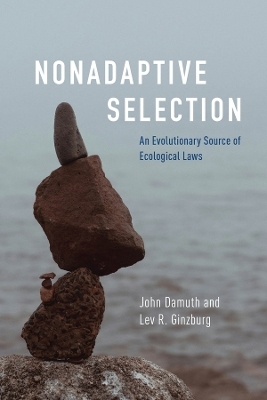
Nonadaptive Selection
University of Chicago Press (Verlag)
978-0-226-83857-1 (ISBN)
- Noch nicht erschienen (ca. Juli 2025)
- Versandkostenfrei innerhalb Deutschlands
- Auch auf Rechnung
- Verfügbarkeit in der Filiale vor Ort prüfen
- Artikel merken
In this important treatise, ecologists and evolutionary biologists John Damuth and Lev R. Ginzburg identify a specific evolutionary process in biology, which they call nonadaptive selection. The idea is simple, but the implications are profound. Nonadaptive selection, as they use the term, is selection among biological entities (as is natural selection) but is based on the fitness effects of structural properties intrinsic to the entities under selection rather than on interactions between traits and a local shared environment. In other words, features of systems that evolve by nonadaptive selection do not adapt to local environmental conditions; rather, this selective process increases the long-term stability of the focal systems independent of local conditions.
Nonadaptive selection may be of particular value in explaining broad, persistent patterns in multispecies biological units where adaptive evolution may be weak or poorly defined. Examples include Damuth’s Law, the equivalence of energy use among animal species across a wide range of body sizes; the ratio-dependent or Arditi-Ginzburg predation conjecture; the consistency of allometric scaling powers; the shortness of trophic chains; and the prevalence of certain types of three-species trophic structures across ecosystems. Damuth and Ginzburg see nonadaptive selection underlying patterns of ecological allometries, community structure, and species interactions with some implications for macroevolution. Moreover, they find a surprising relationship between these nonadaptive processes and biological laws. They do not advocate the reorientation of any existing research programs but present nonadaptive selection as an additional conceptual framework that may be useful to add to ecology and evolution.
John Damuth (1952–2024) was a senior research scientist in the Department of Ecology, Evolution, and Marine Biology at the University of California, Santa Barbara. Lev R. Ginzburg is professor emeritus in the Department of Ecology and Evolution at Stony Brook University. Among his books, he is coauthor of How Species Interact: Altering the Standard View on Trophic Ecology and Ecological Orbits: How Planets Move and Populations Grow.
In Memoriam: John Damuth
Preface
Chapter 1. Selection Processes and Multispecies Systems
1.1. Prologue: Nonadaptive Selection
1.2. An Example: Why Food Chains Are Short
1.3. Goals at the Macroscale
1.4. The Problem of Extrapolation: Why Evolutionary Biology and Ecology Need Selective Processes in Addition to Natural Selection
1.5. The Macroscale
1.6. Nonadaptive Selection as a Solution
Chapter 2. Two Examples: Network Motifs and Damuth’s Law
2.1. From Mechanisms to Patterns to Laws
2.2. Stability of Modules in Food Webs: Network Motifs
2.3. Selective Local Extinction and the Allometries of Energy and Abundance: Damuth’s Law
Chapter 3. Nonadaptive Selection: How It Works
3.1. Nonadaptive Selection Is Distinct, Multifaceted, and Already Embedded in Evolutionary Theory
3.2. Nonadaptive Selection Processes: Do They Generate Laws of Nature?
3.3. The Properties of Macroscale Multispecies Systems
3.4. Summary
Chapter 4. Nonadaptive Selection at the Level of Single Species
4.1. Fisher’s Principle: The Maintenance of Even Sex Ratios
4.2. Nonadaptive Selection Explanation of Heterozygote Fitness Superiority
Chapter 5. Nonadaptive Selection Explains the Size Scaling of Lifespans
5.1. Introduction: The Problem of Lifespan Scaling
5.2. Traditional Explanations
5.3. Physiology and Ecology Interact to Provide a Causal Explanation via Nonadaptive Selection
Chapter 6. Ecological Allometries, Nonadaptive Selection, and the Coordination of Powers
6.1. What Do Ecological Allometries Mean?
6.2. The Coordination of Ecological and Metabolic Power Laws
Chapter 7. Nonadaptive Selection in Multispecies Interaction Networks
7.1. Introduction: Observed, Lawlike Regularities in Multispecies Interactions Are the Result of Nonadaptive Selection
7.2. Consumer Interference
7.3. How Nonadaptive Selection Explains Short Trophic Chains
7.4. Qualitatively Stable Structures, Triangular Matrices, and Asymmetry of Interaction Strengths
7.5. Nonadaptive Selection and Predators Larger Than Their Prey
Chapter 8. Macroevolution: The Role of Nonadaptive Selection among Species
8.1. Introduction
8.2. Species Selection
8.3. Elevated Extinction Rates for Large Hypercarnivores
8.4. Outlook for Selection-Based Macroevolutionary Explanations and Laws
Chapter 9. Summary and Perspective
9.1. Life Elsewhere in the Universe
9.2. The Origin of Adaptation and the Zero-Force Law
9.3. Populating of the Biosphere with Stable Structures
9.4. Conclusion
Chapter 10. Appendices
10.1. Introduction to Allometry (Power Laws)
10.2. Qualitative Stability Conditions
10.3. Allometry and Energy Equivalence (Damuth’s Law)
10.4. The Price Equation
10.5. Kepler’s Planetary Allometry
10.6. Selection Analyses, Multilevel Selection, and Adaptation
10.7. Selection without Adaptation: A 2,300-Year History
10.8. Selection and Adaptation outside of Biology
10.9. Theories, Laws, and Models as Contemporary Philosophy Sees Them
10.10. Heterozygote Fitness Advantage
10.11. Models of Single-Species Population Growth
10.12. Community Interaction Networks, Asymmetry, and QSS
10.13. Species Selection
10.14. What Nonadaptive Selection Is Not
Acknowledgments
Notes
References
Index
| Erscheint lt. Verlag | 10.7.2025 |
|---|---|
| Zusatzinfo | 25 line drawings |
| Sprache | englisch |
| Maße | 152 x 229 mm |
| Gewicht | 454 g |
| Themenwelt | Naturwissenschaften ► Biologie ► Evolution |
| Naturwissenschaften ► Biologie ► Ökologie / Naturschutz | |
| ISBN-10 | 0-226-83857-9 / 0226838579 |
| ISBN-13 | 978-0-226-83857-1 / 9780226838571 |
| Zustand | Neuware |
| Haben Sie eine Frage zum Produkt? |
aus dem Bereich


